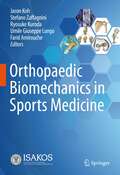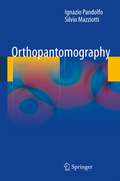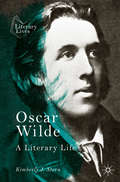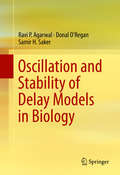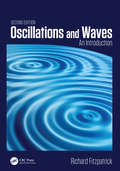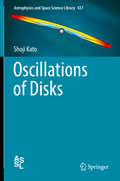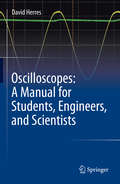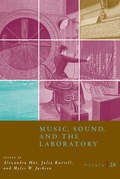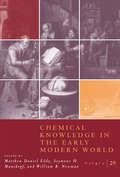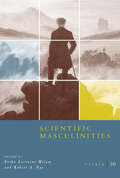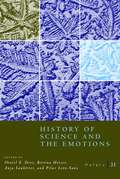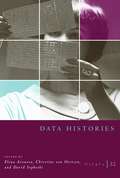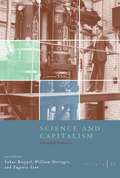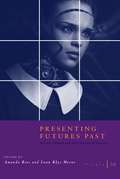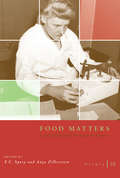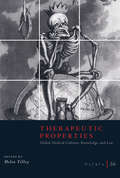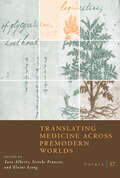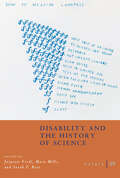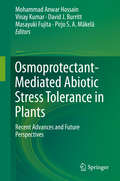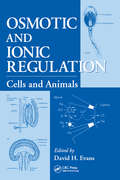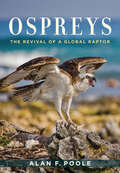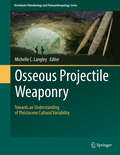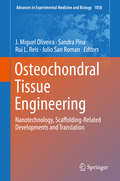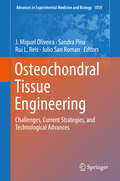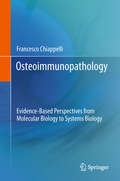- Table View
- List View
Orthopaedic Biomechanics in Sports Medicine
by Jason Koh Stefano Zaffagnini Ryosuke Kuroda Umile Giuseppe Longo Farid AmiroucheThis book presents a fundamental basic overview of orthopedic biomechanics in sports medicine, with a special focus on the current methodologies used in modeling human joints, ligaments, and muscle forces. The first part discusses the principles and materials, including the use of finite element analysis (FEA) to analyze the stress-strain response in the implant-bone interface and design. The second part focuses on joint-specific biomechanics, highlighting the biomechanics of the knee and shoulder joints, their modeling, surgical techniques, and the clinical assessment of joint performance under various kinematic conditions resulting from different repair techniques. Written by international experts working at the cutting edge of their fields, this book is an easy-to-read guide to the fundamentals of biomechanics. It also offers a source of reference for readers wanting to explore new research topics, and is a valuable tool for orthopedic surgeons, residents, and medical students with an interest in orthopedic biomechanics.
Orthopantomography
by Ignazio Pandolfo Silvio MazziottiAlthough orthopantomography (OPT) is a very frequently employed radiological examination, even the expert radiologist can encounter difficulty in reporting the findings owing to the specific terminology, the nature of the diagnostic queries, and the need to describe precisely the clinical implications for the dentist. Additionally, artifacts are a frequent occurrence, and many radiologists and dentists are unfamiliar with their causes and solutions. Methodological inaccuracies during the execution of OPTs also have important clinical implications. For all of these reasons, this richly illustrated monograph on OPT sets out to describe in detail diverse technical and methodological aspects of the examination, from image acquisition through to artifact generation due to lack of experience or malfunctioning. Possible solutions are suggested for all of the most common diagnostic and methodological problems. Emphasis is placed on appropriate terminology and guidance offered on the interpretation of findings in a range of conditions, including the most common odontological problems. This book will be of great value to the radiologist in routine interpretation and reporting of OPTs.
Oscar Wilde: A Literary Life (Literary Lives)
by Kimberly J. SternOscar Wilde: A Literary Life tracks the intellectual biography of one of the most influential minds of the nineteenth century. Rather than focusing on the dramatic events of Wilde’s life, this volume documents Wilde’s impressive forays into education, religion, science, philosophy, and social reform. In so doing, it provides an accessible and yet detailed account that reflects Wilde’s own commitment to the “contemplative life.” Suitable for seasoned readers as well as those new to the study of his work, Oscar Wilde: A Literary Life brings Wilde’s intellectual investments into sharp focus, while placing him within a cultural landscape that was always evolving and often fraught with contradiction.
Oscillation and Stability of Delay Models in Biology
by Ravi P. Agarwal Donal O'Regan Samir H. SakerEnvironmental variation plays an important role in many biological and ecological dynamical systems. This monograph focuses on the study of oscillation and the stability of delay models occurring in biology. The book presents recent research results on the qualitative behavior of mathematical models under different physical and environmental conditions, covering dynamics including the distribution and consumption of food. Researchers in the fields of mathematical modeling, mathematical biology, and population dynamics will be particularly interested in this material.
Oscillations and Waves: An Introduction, Second Edition
by Richard FitzpatrickEmphasizing physics over mathematics, this popular, classroom-tested text helps advanced undergraduates acquire a sound physical understanding of wave phenomena. This second edition of Oscillations and Waves: An Introduction contains new widgets, animations in Python, and exercises, as well as updated chapter content throughout; continuing to ease the difficult transition for students between lower-division courses that mostly encompass algebraic equations and upper-division courses that rely on differential equations. Assuming familiarity with the laws of physics and college-level mathematics, the author covers aspects of optics that crucially depend on the wave-like nature of light, such as wave optics. Examples explore discrete mechanical, optical, and quantum mechanical systems; continuous gases, fluids, and elastic solids; electronic circuits; and electromagnetic waves. The text also introduces the conventional complex representation of oscillations and waves during the discussion of quantum mechanical waves. Features: Fully updated throughout and featuring new widgets, animations, and end of chapter exercises to enhance understanding Provides a clear, concise, systematic, and comprehensive treatment of the subject matter that emphasises physics over mathematics Offers complete coverage of advanced topics in waves, such as electromagnetic wave propagation through the ionosphere Includes examples from mechanical systems, elastic solids, electronic circuits, optical systems, and other areas
Oscillations of Disks
by Shoji KatoThis book presents the current state of research on disk oscillation theory, focusing on relativistic disks and tidally deformed disks. Since the launch of the Rossi X-ray Timing Explorer (RXTE) in 1996, many high-frequency quasiperiodic oscillations (HFQPOs) have been observed in X-ray binaries. Subsequently, similar quasi-periodic oscillations have been found in such relativistic objects as microquasars, ultra-luminous X-ray sources, and galactic nuclei. One of the most promising explanations of their origin is based on oscillations in relativistic disks, and a new field called discoseismology is currently developing. After reviewing observational aspects, the book presents the basic characteristics of disk oscillations, especially focusing on those in relativistic disks. Relativistic disks are essentially different from Newtonian disks in terms of several basic characteristics of their disk oscillations, including the radial distributions of epicyclic frequencies. In order to understand the basic processes of disk oscillations, studies on binary systems are of importance, as they offer valuable information on wave-wave coupling processes in disk oscillations. Accordingly, some characteristics of oscillations in deformed disks are also presented in this book. The book consists of two parts. Points covered in Part I include, for instance, the basic characteristics of disk oscillations, classification of oscillation modes, and trapping of oscillations. In Part II, the focus is mainly on excitation processes of oscillations, while applications to observations are also discussed.
Oscilloscopes: A Manual for Students, Engineers, and Scientists
by David HerresThis text presents readers with an engaging while rigorous manual on the use of oscilloscopes in laboratory and field settings. It describes procedures for measuring and displaying waveforms, gives examples of how this information can be used for repairing malfunctioning equipment and developing new designs, and explains steps for debugging pre-production prototypes. The book begins by examining how the oscilloscope displays electrical energy as traces on X and Y co-ordinates, freely transitioning without loss of information between time and frequency domains, in accordance with the Fourier Transform and its modern correlate, the Fast Fourier Transform. The book continues with practical applications and case studies, describes how oscilloscopes are used in diagnosing pulse width modulation (PWM) problems--looking at serial data streaming and analyzing power supply noise and premises power quality issues—and emphasizes the great functionality of mixed-signal as opposed to mixed-domain oscilloscope, and earlier instruments. Featuring many descriptions of applications in applied science and physics, Oscilloscopes: A Manual for Students, Engineers, and Scientists is ideal for students, faculty, and practitioners.
Osiris, Volume 28: Music, Sound, and the Laboratory from 1750-1980 (Osiris #28)
by The University of Chicago PressThe understanding of sound underwent profound changes with the advent of laboratory science in the nineteenth and twentieth centuries. New techniques of sound visualization and detection, the use of electricity to generate sound, and the emergence of computers radically reshaped the science of acoustics and the practice of music. The essays in this volume of Osiris explore the manifold transformations of sound ranging from soundproof rooms to psychoacoustics of seismology to galvanic music to pedaling technique. They also discuss more general themes such as the nature of scientific evidence and the development of instruments and instrumentation. In examining the reciprocity between music and science, this volume reaches a new register in the evolution of scientific methodology during the nineteenth and twentieth centuries.
Osiris, Volume 29: Chemical Knowledge in the Early Modern World (Osiris #29)
by The University of Chicago PressThe last twenty-five years have witnessed some provocative transmutations in our understanding of early modern chemistry. The alchemist, once marginalized as a quack, now joins the apothecary, miner, humanist, and natural historian as a practitioner of “chymistry.” In a similar vein, the Chemical Revolution of the eighteenth century, with its focus on phlogiston and airs, has been expanded to include artisanal, medical, and industrial practices. This collection of essays builds on these reappraisals and excavates the affinities between alchemy, chymistry, and chemistry from the sixteenth to the eighteenth centuries. It reveals a rich world of theory and practice in which instruments, institutions, inscriptions and ideas were used to make material knowledge. More generally, the volume will catalyze wide-ranging discussions of material and visual cultures, the role of expertise, and the religious and practical contexts of scientific inquiry.
Osiris, Volume 30: Scientific Masculinities (Osiris #30)
by The University of Chicago PressThis volume of Osiris integrates gender analysis with the global history of science and medicine from the late Middle Ages to the present by focusing on masculinity. The premise is that social constructions of masculinity function simultaneously as foils for femininity and as methods of differentiating between “kinds” of men. In exploring scientific masculinities, the book asks: how has masculinity been defined, and what are the mechanisms by which it operates in science? The essays are divided into sections that emphasize the importance of gender to the practices of professionalization, the spaces in which scientific, technological, and medical labor is performed, and the ways that sex, gender, and sexual orientation are measured and serve as metaphors in society and culture.
Osiris, Volume 31: History of Science and the Emotions (Osiris #31)
by The University of Chicago PressWhat new insights become available for historians when emotions are included as an analytical category? This volume of Osiris explores the historical interrelationships between science and its cultures and cultures of emotions. It argues that a dialogue between the history of emotions and the history of science leads to a rethinking of our categories of analysis, our subjects, and our periodizations. The ten case studies in the volume explore these possibilities and interrelationships across North America and Europe, between the twelfth and the twentieth centuries, in a variety of scientific disciplines. They analyze how scientific communities approached and explained the functions of emotions; how the concomitant positioning of emotions in or between body-mind-intersubjectivity took place; how emotions infused practices and how practices generated emotions; and, ultimately, how new and emerging identities of and criteria for emotions created new knowledge, new technologies, and new subjectivities.
Osiris, Volume 32: Data Histories (Osiris #32)
by The University of Chicago PressThe history of data brings together topics and themes from a variety of perspectives in history of science: histories of the material culture of information and of computing, the history of politics on individual and global scales, gender and women’s history, as well as the histories of many individual disciplines, to name just a few of the areas covered by essays in this volume. But the history of data is more than just the sum of its parts. It provides an emerging new rubric for considering the impact of changes in cultures of information in the sciences in the longue durée, and an opportunity for historians to rethink important questions that cross many of our traditional disciplinary categories.
Osiris, Volume 33: Science and Capitalism: Entangled Histories (Osiris #33)
by The University of Chicago PressThe historical relationship between science and capitalism has long stood as a central question in science studies, at least since its foundations in the 1930s. Taking inspiration from the recent surge of scholarly interest in the “history of capitalism,” as well as from renewed attention to political economy by historians of science and technology, this Osiris volume revisits this classic quandary, foregrounding the entanglements between these two powerful and unruly historical forces and tracing the diverse ways they mutually shaped each other. Key attention is paid to the practices of knowledge work that enable both scientific and capitalistic action and to the diversity of global sites and circuits in which science/capitalism have been performed. The assembled papers excavate an array of tangled nodes at the science/capitalism nexus, spanning from the seventeenth century to the twenty-first, from Nevada to Central Asia to Japan, from microbiology to industrial psychology to public health.
Osiris, Volume 34: Presenting Futures Past: Science Fiction and the History of Science (Osiris)
by The University of Chicago PressThe role of fiction in both understanding and interpreting the world has recently become an increasingly important topic for many of the human sciences. This volume of Osiris focuses on the relationship between a particular genre of storytelling—science fiction (SF), told through a variety of media—and the history of science. The protagonists of these two enterprises have a lot in common. Both SF and the history of science are oriented towards the (re)construction of unfamiliar worlds; both are fascinated by the ways in which natural and social systems interact; both are critically aware of the different ways in which the social (class, gender, race, sex, species) has inflected the experience of the scientific. Taking a global approach, Presenting Futures Past examines the ways in which SF can be used to investigate the cultural status and authority afforded to science at different times and in different places. The essays consider the role played by SF in the history of specific scientific disciplines, topics, or cultures, as well as the ways in which it has helped to move scientific concepts, methodologies, and practices between wider cultural areas. Ultimately, Presenting Futures Past explores what SF can tell us about the histories of the future, how different communities have envisaged their futures, and how SF conveys the socioscientific claims of past presents.
Osiris, volume 35 number 1 (2020)
by OsirisThis is volume 35 issue 1 of Osiris. Founded in 1936 by George Sarton, and relaunched by the History of Science Society in 1985, Osiris is an annual thematic journal that highlights research on significant themes in the history of science. Recent volumes have included Scientific Masculinities, History of Science and the Emotions, and Data Histories.
Osiris, volume 36 number 1 (2021)
by OsirisThis is volume 36 issue 1 of Osiris. Founded in 1936 by George Sarton, and relaunched by the History of Science Society in 1985, Osiris is an annual thematic journal that highlights research on significant themes in the history of science. Recent volumes have included Scientific Masculinities, History of Science and the Emotions, and Data Histories.
Osiris, Volume 37: Translating Medicine across Premodern Worlds (Osiris #37)
by The University of Chicago PressHighlights the importance of translation for the global exchange of medical theories, practices, and materials in the premodern period. This volume of Osiris turns the analytical lens of translation onto medical knowledge and practices across the premodern world. Understandings of the human body, and of diseases and their cures, were influenced by a range of religious, cultural, environmental, and intellectual factors. As a result, complex systems of translation emerged as people crossed linguistic and territorial boundaries to share not only theories and concepts, but also materials, such as drugs, amulets, and surgical tools. The studies here reveal how instances of translation helped to shape and, in some cases, reimagine these ideas and objects to fit within local frameworks of medical belief. Translating Medicine across Premodern Worlds features case studies located in geographically and temporally diverse contexts, including ninth-century Baghdad, sixteenth-century Seville, seventeenth-century Cartagena, and nineteenth-century Bengal. Throughout, the contributors explore common themes and divergent experiences associated with a variety of historical endeavors to “translate” knowledge about health and the body across languages, practices, and media. By deconstructing traditional narratives and de-emphasizing well-worn dichotomies, this volume ultimately offers a fresh and innovative approach to histories of knowledge.
Osiris, Volume 39: Disability and the History of Science (Osiris #39)
by The University of Chicago PressPresents a powerful new vision of the history of science through the lens of disability studies. Disability has been a central—if unacknowledged—force in the history of science, as in the scientific disciplines. Across historical epistemology and laboratory research, disability has been “good to think with”: an object of investigation made to yield generalizable truths. Yet disability is rarely imagined to be the source of expertise, especially the kind of expertise that produces (rational, neutral, universal) scientific knowledge. This volume of Osiris places disability history and the history of science in conversation to foreground disability epistemologies, disabled scientists, and disability sciencing (engagement with scientific tools and processes). Looking beyond paradigms of medicalization and industrialization, the volume authors also examine knowledge production about disability from the ancient world to the present in fields ranging from mathematics to the social sciences, resulting in groundbreaking histories of taken-for-granted terms such as impairment, infirmity, epidemics, and shōgai. Some contributors trace the disabling impacts of scientific theories and practices in the contexts of war, factory labor, insurance, and colonialism; others excavate racial and settler ableism in the history of scientific facts, protocols, and collections; still others query the boundaries between scientific, lay, and disability expertise. Contending that disability alters method, authors bring new sources and interpretation techniques to the history of science, overturn familiar narratives, apply disability analyses to established terms and archives, and discuss accessibility issues for disabled historians. The resulting volume announces a disability history of science.
Osmoprotectant-Mediated Abiotic Stress Tolerance in Plants: Recent Advances and Future Perspectives
by Mohammad Anwar Hossain Vinay Kumar David J. Burritt Masayuki Fujita Pirjo S. A. MäkeläIn nature, plants are constantly challenged by various abiotic and biotic stresses that can restrict their growth, development and yields. In the course of their evolution, plants have evolved a variety of sophisticated and efficient mechanisms to sense, respond to, and adapt to changes in the surrounding environment. A common defensive mechanism activated by plants in response to abiotic stress is the production and accumulation of compatible solutes (also called osmolytes). This include amino acids (mainly proline), amines (such as glycinebetaine and polyamines), and sugars (such as trehalose and sugar alcohols), all of which are readily soluble in water and non-toxic at high concentrations. The metabolic pathways involved in the biosynthesis and catabolism of compatible solutes, and the mechanisms that regulate their cellular concentrations and compartmentalization are well characterized in many important plant species. Numerous studies have provided evidence that enhanced accumulation of compatible solutes in plants correlates with increased resistance to abiotic stresses. New insights into the mechanisms associated with osmolyte accumulation in transgenic plants and the responses of plants to exogenous application of osmolyte, will further enhance our understanding of the mechanisms by which compatible solutes help to protect plants from damage due to abiotic stress and the potential roles compatible solutes could play in improving plants growth and development under optimal conditions for growth. Although there has been significant progress made in understanding the multiple roles of compatible solute in abiotic stress tolerance, many aspects associated with compatible solute-mediated abiotic stress responses and stress tolerance still require more research. As well as providing basic up-to-date information on the biosynthesis, compartmentalization and transport of compatible solute in plants, this book will also give insights into the direct or indirect involvement of these key compatible solutes in many important metabolic processes and physiological functions, including their antioxidant and signaling functions, and roles in modulating plant growth, development and abiotic stress tolerance. In this book, Osmoprotectant-mediated abiotic stress tolerance in plants: recent advances and future perspectives, we present a collection of 16 chapters written by leading experts engaged with compatible solute-induced abiotic stress tolerance in plants. The main objective of this volume is to promote the important roles of these compatible solutes in plant biology, by providing an integrated and comprehensive mix of basic and advanced information for students, scholars and scientists interested in, or already engaged in, research involving osmoprotectant. Finally, this book will be a valuable resource for future environmental stress-related research, and can be considered as a textbook for graduate students and as a reference book for front-line researchers working on the relationships between osmoprotectant and abiotic stress responses and tolerance in plants.
Osmotic and Ionic Regulation: Cells and Animals
by David H. EvansIn the 40 years since the classic review of osmotic and ionic regulation written by Potts and Parry, there has been astonishing growth in scientific productivity, a marked shift in the direction and taxonomic distribution of research, and amazing changes in the technology of scientific research" It is indicative of the growth of the subject that as
Ospreys: The Revival of a Global Raptor
by Alan F. PooleA fascinating look at one of the greatest conservation success stories of the modern era: the wildly popular, unique, and thrilling raptor, the Osprey.Ospreys are one of the few bird species that are found throughout the world. From forests in Hokkaido to rivers in Oregon and islands off Australia, Ospreys steal the show as nature lovers easily watch them build their massive nests and tend to their young. The fact that the Osprey is one of the few large birds that can hover adds to its mystique, and to watch it plunge into the water, emerging with a fish clutched in its talons, is truly a sight one will remember. As widespread as Ospreys are, not long ago they were under threat of extinction. During the 1950s and '60s, scientists tied the decline of Osprey populations to the heavy use of DDT and other human pollutants. In the 1980s, Ospreys began a slow recovery due to the efforts of conservationists and through the resilience of the adaptable raptors themselves. Today they are again considered common in most parts of the world, although some populations remain threatened.In this gorgeously illustrated book, Alan F. Poole, one of America's premier Osprey experts, has written a lyrical exposé of these majestic creatures, describing their daily habits and exploring their relationship with the environment. Ospreys celebrates the species' miraculous recovery from contaminants and hunters, chronicles their spectacular long-distance migrations, and unveils their vital role in bringing life to coastal habitats. Few other birds have such a hold on the human imagination. This book shows us why.
Osseous Projectile Weaponry
by Michelle C. LangleyThis volume presents the current state of knowledge on the osseous projectile weaponry that was produced by Pleistocene cultures across the globe. Through cross-cultural and temporal comparison of manufacturing methods, design, use methods, and associated technology, chapters in this volume identify and discuss differences and similarities between these Pleistocene cultures. The central research questions addressed in this volume include: (a) how did osseous weaponry technology develop and change through time and can these changes be tied to environmental and/or social influences?; (b) how did different Pleistocene cultures design and adapt their osseous weaponry technology to their environment as well as changes in that environment?; and (c) can we identify cultural interaction between neighboring groups through the analysis of osseous weapons technology -- and if so -- can we use these items to track the movement of peoples and/or ideas across the landscape? Through addressing these three central research questions, this volume creates an integrated understanding of osseous technology during a vital period in Modern Human cultural development which will be useful for students and advanced researchers alike.
Osteochondral Tissue Engineering: Challenges, Current Strategies, And Technological Advances (Advances In Experimental Medicine And Biology #1059)
by J. Miguel Oliveira Sandra Pina Rui L. Reis Julio San RomanThis book reviews the most recent developments in the field of osteochondral tissue engineering (OCTE) and presents challenges and strategies being developed that face not only bone and cartilage regeneration, but also establish osteochondral interface formation in order to translate it into a clinical setting. Topics include nanotechnology approaches and biomaterials advances in osteochondral engineering, advanced processing methodology, as well as scaffolding and surface engineering strategies in OCTE. Hydrogel systems for osteochondral applications are also detailed thoroughly. Osteochondral Tissue Engineering: Nanotechnology, Scaffolding-Related Developments and Translation is an ideal book for biomedical engineering students and a wide range of established researchers and professionals working in the orthopedic field.
Osteochondral Tissue Engineering: Challenges, Current Strategies, And Technological Advances (Advances In Experimental Medicine And Biology #1059)
by Julio San Roman Sandra Pina J. Miguel Oliveira Rui L. ReisThis book covers the most recent developments in the field of osteochondral tissue engineering (OCTE) and covers in detail the concepts and current challenges for bone and cartilage repair and regeneration. Specific topics include viscosupplementation, biologicals, tissue engineering approaches, in vitro and in vivo models, and technological advances with stem cells, bioreactors, and microfluidics. Osteochondral Tissue Engineering: Challenges, Current Strategies, and Technological Advances presents challenges and strategies in the field of osteochondral regeneration and serves as a core reference for biomedical engineering students and a wide range of established researchers and professionals working in orthopedics.
Osteoimmunopathology
by Francesco ChiappelliOsteoimmunology pertains to the study of the relationship between the bones, particularly the bone marrow, and the immune system. This monograph pursues the best available evidence, by means of research synthesis, for the characterization of the physiological relevance and pathological implications of the inter-connectedness between the skeletal and the immune system. Research will be discussed that highlights the associated role of the circulatory, nervous and endocrine systems, as well as proteomic and genomic pathways and signatures. Emphasis is given that domain of medicine that relates to the oral cavity, its diseases and their systemic sequelae. This monograph arises from observations that have suggested that the skeletal system and the immune system are intimately intertwined. Chronic inflammatory reactions subsequent to an excessive immune reaction can damage the bones, as in rheumatoid arthritis (RA), osteoporosis, patients seropositive for the human immunodeficiency virus (HIV)-1 and with signs and symptoms of the acquired immune deficiency syndrome (AIDS), and bone cancer. Bones - in particular the bone marrow - are one of the primary locations in which cells of the immune system mature. In brief, this monograph begins to answer a range of questions, such as, what is osteoimmunology all about?, does the immune system and its components affect bone development?, how do stress hormones impact upon the pathophysiology of bone-immune interactions?, can the scientific process of research synthesis, obtain the best available evidence for treatment of diseases involving the bone-immune entity (i.e., osteo immunopathologies) means of evidence-based clinical decision-making directed at the treatment of osteoimmune pathologies?
